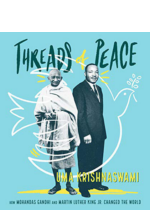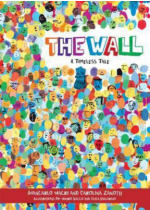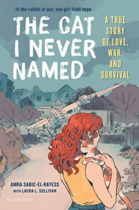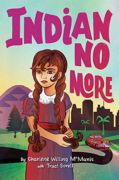
A look at the lives of Ghandi and Martin Luther King Jr. and how they were led to seek revolution through peace.

A look at the lives of Ghandi and Martin Luther King Jr. and how they were led to seek revolution through peace.

With engaging illustrations packed with fun thumbprint faces, a pop-up wall, and an important lesson about diversity that’s relevant to the world today, The Wall will help children see how a society can be harmed when barriers are built, but thrive when everyone works together.
Meera’s future has been planned for her for as long as she can remember. As a child, her parents married her to a boy from a neighboring village whom she barely knows. Later, on the eve of her thirteenth birthday, she prepares to leave her family to live with her husband’s–just as her strict religion dictates. But that night, Indian soldiers mutiny against their British commanders and destroy the British ammunition depot, burning down parts of Delhi. Riots follow, and Meera’s husband is killed. Upon hearing the news, Meera’s father insists that she follow the dictates of their fringe religious sect: She must end her life by throwing herself on her husband’s funeral pyre.

In 1992, Amra was a teen in Bihac, Bosnia, when her best friend said they couldn’t speak anymore. Her friend didn’t say why, but Amra knew the reason: Amra was Muslim. It was the first sign her world was changing. Then Muslim refugees from other Bosnian cities started arriving, fleeing Serbian persecution. When the tanks rolled into Bihac, bringing her own city under seige, Amra’s happy life in her peaceful city vanished.
For Hasina and her younger brother Araf, the constant threat of Sit Tat, the Myanmar Army, is a way of life in Rakhine province—just uttering the name is enough to send chills down their spines. As Rohingyas, they know that when they hear the wop wop wop of their helicopters there is one thing to do—run, and don’t stop. So when soldiers invade their village one night, and Hasina awakes to her aunt’s fearful voice, followed by smoke, and then a scream, run is what they do.
“In the years before World War II, Adolf Hitler wanted to prove the greatness of the Third Reich in everything from track and field to motorsports. The Nazis poured money into the development of new race cars, and Mercedes-Benz came out with a stable of supercharged automobiles called Silver Arrows. Their drivers dominated the sensational world of European Grand Prix racing and saluted Hitler on their many returns home with victory. As the Third Reich stripped Jews of their rights and began their march toward war, one driver, Rene Dreyfus, a 32-year-old Frenchman of Jewish heritage who had enjoyed some early successes on the racing circuit, was barred from driving on any German or Italian race teams, which fielded the best in class, due to the rise of Hitler and Benito Mussolini. So it was that in 1937, Lucy Schell, an American heiress and top Monte Carlo Rally driver, needed a racer for a new team she was creating to take on Germany’s Silver Arrows. Sensing untapped potential in Dreyfus, she funded the development of a nimble tiger of a new car built by a little-known French manufacturer called Delahaye. As the nations of Europe marched ever closer to war, Schell and Dreyfus faced down Hitler’s top drivers, and the world held its breath in anticipation, waiting to see who would triumph”–
Between 1882 and 1968 there were 4,742 lynchings in the United States. In Canada during the same period there was one–the hanging of American Indian Louie Sam. The year is 1884, and 15-year-old George Gillies lives in the Washington Territory, near the border with British Columbia. In this newly settled land, white immigrants have an uneasy relationship with the Native Indians. When George and his siblings discover the murdered body of a local white man, suspicion immediately falls on a young Indian named Louie Sam. George and his best friend, Pete, follow a lynch mob north into Canada, where the terrified boy is seized and hung. But even before the deed is done, George begins to have doubts. Louie Sam was a boy, only 14–could he really be a vicious murderer? Were the mob leaders motivated by justice, or were they hiding their own guilt? As George uncovers the truth–implicating Pete’s father and other prominent locals–tensions in the town rise, and he must face his own part in the tragedy. But standing up for justice has devastating consequences for George and his family. Inspired by the true story of the lynching, recently acknowledged as a historical injustice by Washington State, this powerful novel offers a stark depiction of historical racism and the harshness of settler life. The story will provoke readers to reflect on the dangers of mob mentality and the importance of speaking up for what’s right.
Tired of reading negative and disparaging remarks directed at the Indigenous people of Winnipeg in the press and social media, artist KC Adams created a photo series that presented another perspective. Called “Perception Photo Series,” it confronted common stereotypes of First Nation, Inuit and Métis people to illustrate a more contemporary, truthful story. First appearing on billboards, on storefronts, in bus shelters and on Winnipeg’s downtown buildings as projections, Adams’s stunning photographs now appear in her new book, Perception: A Photo Series. Meant to challenge the culture of apathy and willful ignorance about Indigenous issues, Adams hopes to unite readers in the fight against prejudice of all kinds.
Featured in WOW Review Volume XII, Issue 4

Regina Petit’s family has always been Umpqua, and living on the Grand Ronde reservation is all 10-year-old Regina has ever known. Her biggest worry is that Sasquatch may actually exist out in the forest. But when the federal government signs a bill into law that says Regina’s tribe no longer exists, Regina becomes “Indian no more” overnight–even though she was given a number by the Bureau of Indian Affairs that counted her as Indian, even though she lives with her tribe and practices tribal customs, and even though her ancestors were Indian for countless generations. With no good jobs available in Oregon, Regina’s father signs the family up for the Indian Relocation program and moves them to Los Angeles. Regina finds a whole new world in her neighborhood on 58th Place. She’s never met kids of other races, and they’ve never met a real Indian. For the first time in her life, Regina comes face to face with the viciousness of racism, personally and toward her new friends. Meanwhile, her father believes that if he works hard, their family will be treated just like white Americans. But it’s not that easy. It’s 1957 during the Civil Rights Era. The family struggles without their tribal community and land. At least Regina has her grandmother, Chich, and her stories. At least they are all together.

In a world dominated by the brutal Vathek empire, eighteen-year-old Amani is a dreamer. She dreams of what life was like before the occupation; she dreams of writing poetry like the old-world poems she adores; she dreams of receiving a sign from Dihya that one day, she, too, will have adventure, and travel beyond her isolated home. But when adventure comes for Amani, it is not what she expects: she is kidnapped by the regime and taken in secret to the royal palace, where she discovers that she is nearly identical to the cruel half-Vathek Princess Maram. The princess is so hated by her conquered people that she requires a body double, someone to appear in public as Maram, ready to die in her place. As Amani is forced into her new role, she can’t help but enjoy the palace’s beauty―and her time with the princess’ fiancé, Idris. But the glitter of the royal court belies a world of violence and fear. If Amani ever wishes to see her family again, she must play the princess to perfection…because one wrong move could lead to her death.